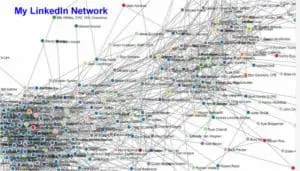 If you aren’t leveraging LinkedIn to make meaningful connections and find new B2B sales leads, you’re missing out on a major opportunity. I’ve written previously about various ways to use LinkedIn, but today let’s focus on the often-ignored LinkedIn keywords.
If you aren’t leveraging LinkedIn to make meaningful connections and find new B2B sales leads, you’re missing out on a major opportunity. I’ve written previously about various ways to use LinkedIn, but today let’s focus on the often-ignored LinkedIn keywords.
LinkedIn is perfectly designed to help you search for B2b sales leads and uncover relationships that may have previously been invisible to you. Of course, you can also get information about the companies with which those individuals are affiliated. Developing a strategy for finding the right people on LinkedIn will be your ticket to improved ROI.
What is my strategy for searching LinkedIn?
The development of your strategy to search LinkedIn for B2B sales leads boils down to being able to answer and work through the following five questions:
- Who do I want to meet?
- What keywords would those individuals use to describe themselves?
- What LinkedIn groups do those types of individuals usually join?
- What relationship(s) can I leverage to assist me in meeting those individuals?
- What goals or objectives can I set relating to those types of individuals?
Once you decide who you want to meet, you’ll need to find the right keywords for your search. Identify the different keywords those types of individuals usually use to describe themselves. If you are having trouble with this, start by looking at the profiles for some of your current connections who are in the same category (customer, employee, etc.) and identify the keywords they have included in their profiles.
Finds some groups that your target person might join by searching Groups by keyword. Or simply look at which groups your current similar connections have joined.
Now use those keywords you have identified in the Advanced Search function, along with any other relevant criteria (such as geographic region), and perform a search to identify potential targets. You can also use the same keywords to search in the groups to which you belong. This will help you find people you would like to meet and show you how you are connected to them, whether as a member of the same group or through a first or second-degree connection.
Next, you will want to come up with specific actionable goals related to those types of individuals. Those goals may look something like this:
- I am going to use LinkedIn to identify, get introduced to, and meet two new people from this category each month.
- I am going to join a new group or association that this category of individual belongs to.
- I am going to write a great — but very short — introductory email and send it to some of my 1st level connections.
- I am going to set up one of my LinkedIn saved searches to find individuals who meet the criteria for one of these categories.
- I am going to review the connections of at least one of my first-degree connections in a target industry in order to find new people to connect with on a monthly basis.
Inbound marketing and LinkedIn
There are 2 main approaches for using LinkedIn for lead generation. The first approach is to provide prospects information about your company directly on LinkedIn. The second, more indirect approach, is to start the conversation on LinkedIn but then drive the prospect through to a landing page on your website.
The first approach — to provide prospects information directly on LinkedIn — is terrific, especially if you reach out to people with their interests in mind. If you’re going to use the direct approach, get to know the prospect first. Try to be helpful by offering advice, industry insights or general information before you turn it into a sales call.
The indirect approach is to drive people to a landing page where they can download a white paper, sign up for your e-newsletter, or get more information on your products or services.
Here’s the trick with this second approach — you still want to start out by offering free advice or helpful information to your customer prospect. The rules of engagement are the same as the direct approach, but the difference is that once you’ve connected with your prospect on LinkedIn, you drive them to your landing page.
There are over 107 million LinkedIn users in the US alone. Develop your strategy and then get to work on a regular basis to find your B2B sales leads on LinkedIn. According to HubSpot, LinkedIn is 277% more effective for lead generation than Facebook or Twitter. Go got ’em, tiger!
LinkedIn network view created by socilab.
![]()





